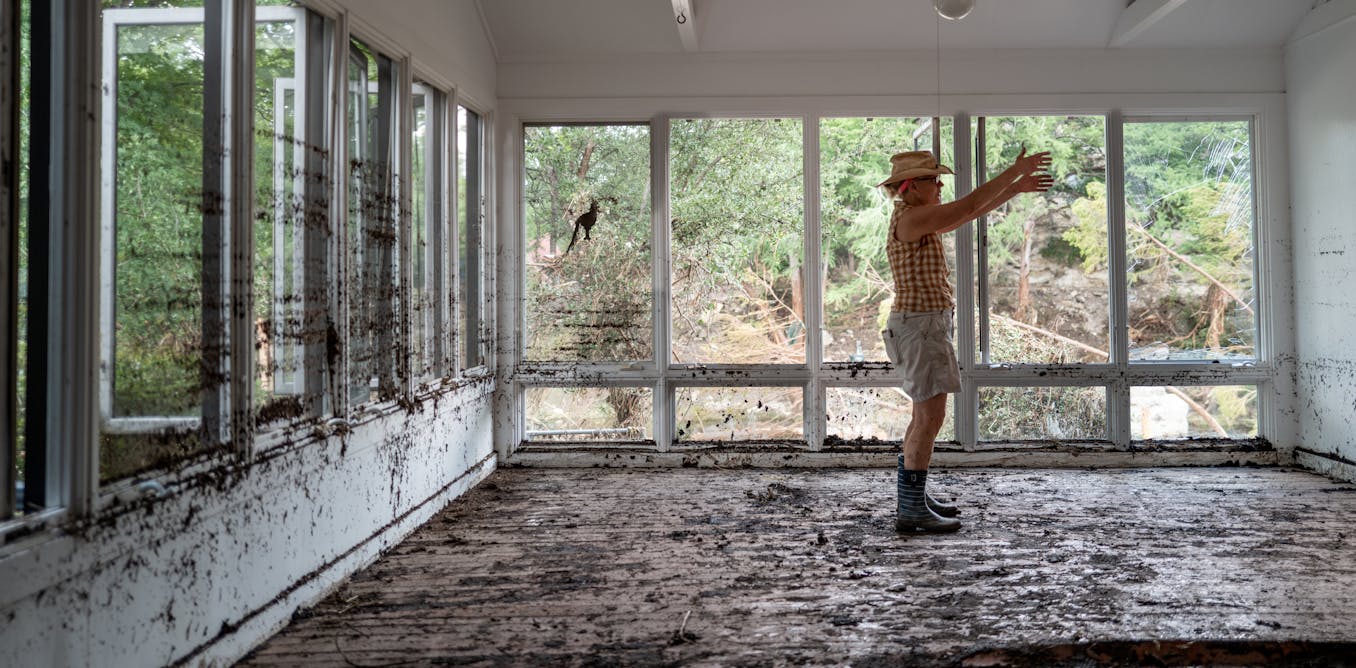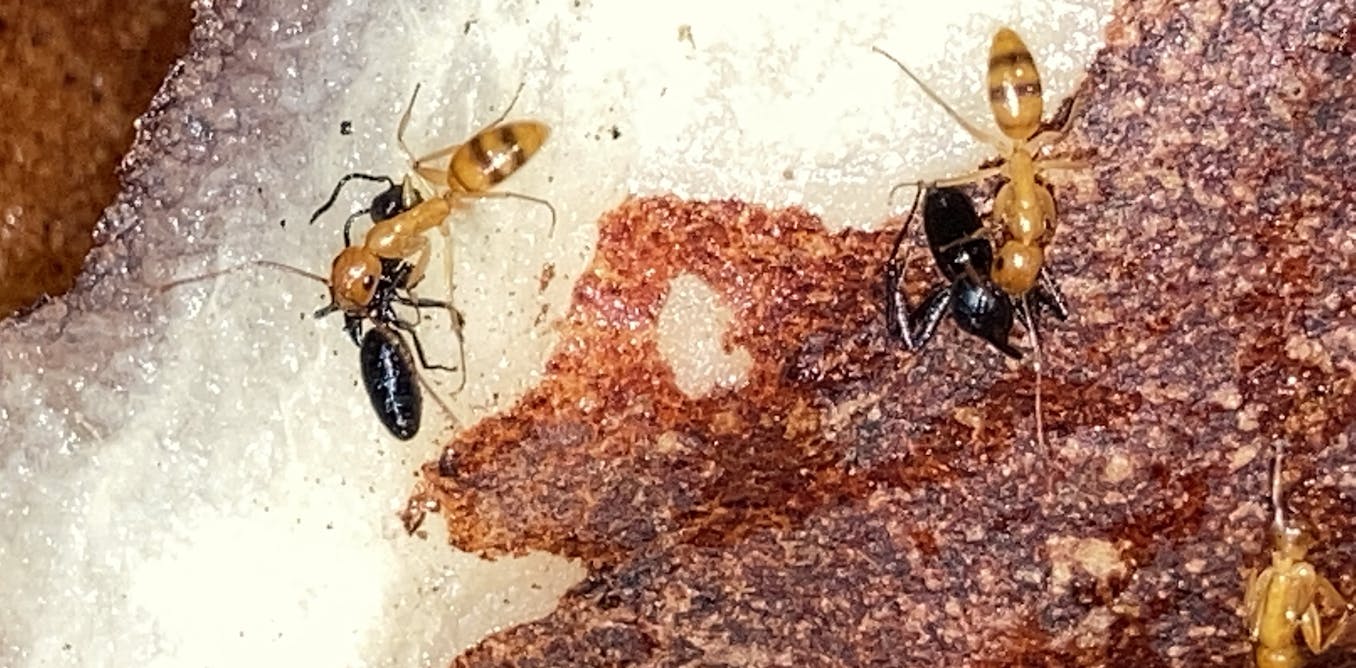Watch the video by The Ultimate Discovery
Top 15 Scariest Tribes you don’t want to meet. In the heart of some of the world’s most remote and unforgiving landscapes lie tribes whose existence is shrouded in mystery and fear. They possess a set of strange customs, beliefs, and practices that have sent shivers down the spines of even the most daring explorers. From the dense jungles of the Amazon to the remote islands of the Pacific, these tribes have thrived for centuries, fiercely guarding their traditions and territories against outsiders. So, join us as we unravel fifteen of the scariest tribes you don’t want to meet!
We use Clonedub.com to translate our channel into different languages.
Check Out These Videos:
15 Scariest Tribes You Don’t Want to Meet
6 Scariest Tribes You Don’t Want To Meet
Scariest Tribes You Don’t Want to Meet
https://www.youtube.com/watch?v=_74RfkW-jZE
In the heart of some of the world’s most remote and unforgiving Landscapes lie tribes whose existence is shrouded in mystery and fear they possess a set of strange Customs beliefs and practices that have sent shivers down the spines of even the most daring explorers from the dense jungles of the Amazon to the
Remote islands of the Pacific these tribes have thrived for centuries fiercely guarding their traditions and territories against Outsiders so join us as we unravel 50 of the scariest tribes you don’t want to meet number 15 Asmat tribe the asot tribe with their unique culture and rituals has fascinated
Researchers for decades living in the remote and challenging environment of the mangrove thickets in Papua New Guinea they have developed unique customs and traditions that set them apart from other societies one of the most striking aspects of their culture is their wood carving skills they are renowned for their ability to craft
Detailed wooden statues sculptures and artifacts often representing historic figures spirits and animals these artworks serve not only as decorative pieces but also as symbols of their spiritual beliefs and connection to the Natural World in addition to their artistic skill the people have a deep spiritual connection to the forest they
Believe that the forest is inhabited by powerful spirits and ancestors and they conduct elaborate rituals and ceremon Monies to honor and communicate with them these rituals often involve complicated dances chants and offerings to appease the spirits and seek their guidance furthermore the asmats cannibalistic practices were not merely
Acts of brutality but were deeply rooted in their religious beliefs and cultural Traditions they believed that by consuming the Flesh of their enemies they could gain their strength and knowledge ensuring the survival and prosperity of their Community however it’s important to note that cannibalism was not a daily occurrence but rather reserved for
Specific ceremonial occasions or as a means of revenge against enemy despite their fearsome reputation they were also skilled Navigators and Traders traversing the disloyal Waters of the mangrove swamps in complicated carved canoes to trade with neighboring tribes these trading Expeditions allowed them to exchange goods knowledge and cultural practices promoting connections and
Alliances across the region overall the tribe’s complex and mixed culture offers a fascinating window into the diversity of human societies and the ways in which they adapt to and interact with their environment number 14 North sentinelles The Sentinel e people residing on North Sentinel Island in the Bay of Bengal are
Among the last uncontacted tribes in the world with their lineage tracing back tens of thousands of years they have developed a unique and self sustaining way of life that remains largely unchanged by modern civilization attempts were made to establish contact with them in the late 1960s but the encounters quickly turned
Hostile despite efforts to reach out the government eventually abandoned the idea in the mid 1990s due to the trib’s determined unfriendliness and the risk of exposing them to external diseases despite numerous attempts by Outsiders to establish contact with them they have fiercely resisted any form of interaction maintaining their isolation
And autonomy even efforts to provide Aid or assistance have been met with anger as they view Outsiders as potential threats to their way of life in addition to their isolation they are known for their exceptional skills in Hunting Fishing and survival in their tropical island environment they rely on traditional
Methods of subsistence such as using bows and arrows for hunting and fishing in the surrounding Wat ERS the Indian government has implemented strict regulations to protect them and their territory in addition to the 5 km buffer zone around the island which prohibits unauthorized access the entire North Sentinel Island is off limits to
Visitors and researchers without official permission despite their isolation they have occasionally made headlines for their encounters with Outsiders in 2006 two fishermen who trespassed too close to the island were killed by them prompting A Renewed emphasis on respecting their territory and autonomy number 13 Bak tribe the Bak
People of Palawan have a rich cultural heritage that spans Centuries with their Roots tracing back to prehistoric times despite their relatively small population they have managed to preserve their traditional way of life and customs in the face of modernization their livelihood primarily relies on swedden farming hunting and Gathering natural resources like honey
Rattan poles and almaa resin with creeks rivers and occasional sea access as their main sources of food the Bak are known for their agility and adaptability in addition to their physical characteristics such as short stature dark skin and curly hair the people are known for their resilience and resourcefulness in adapting to their
Environment they have developed complicated knowledge of the local flora and fauna allowing them to sustain themselves through various means such as farming hunting and Gathering one of the most fascinating aspects of their culture is their deep spiritual connection to Nature they believe in the existence of nature spirits that reside
In the rocks and trees of their environment these Spirits are respected and invoked through rituals and ceremonies believed to possess the power to heal and protect the community they were once estimated to number around 1,000 individuals at the turn of the century the 1,000 990 census counted only 450 currently there are eight
Communities where they reside maintaining their traditional way of life amidst the changing world around them their social structure is characterized by a system of governance led by a Chieftain who is chosen by the Elders of the community this traditional form of leadership ensures that decisions are made collectively and in
The best interest of the group despite their remote location and traditional way of life the people have faced challenges in recent years including Invasion on their land and resources however they continue to persevere holding on to their cultural identity and values number 12 Naga Head Hunters the Naga head hunters and Indigenous
Tribe residing in the remote Northeastern region of India have long captured the imagination of Outsiders with their formidable reputation and distinctive cultural practices their territory surrounds the rugged Hills and thick forests of nagaland Manipur and AR unical Pradesh where they have maintained their way of life for centuries renowned for their Mastery
Over venomous snakes the nagas are known to handle these reptiles with remarkable skill often incorporating them into their rituals and ceremonies to instill fear in their enemies additionally their expertise in head hunting an ancient tradition soaked in both ritual and warfare has gathered attention from archaeologists and historians worldwide
Deeply rooted in Superstition they hold the belief that the human head holds huge spiritual significance they regard it as the holiest part of the body attributing great power to it by collecting the heads of their foes they seek to appease their deities and invite blessings upon their tribe this age-old
Custom reflects their strong faith in the Supernatural and underscores the importance they place on their cultural heritage despite the invasion of modernity and and external influences they continue to uphold their cultural identity and traditions however with shifting demographics increased connectivity and evolving societal ways of life the future of their age-old Customs remains
Uncertain making their way of life all the more intriguing and worthy of study number 11 skeleton Clan the skeleton Clan also known as the zorox tribe resides in a remote and isolated region deep within the thick forest of a distant land despite their non-import they have captured the imagination of
Researchers and explorers alike due to their mysterious Origins and unique characteristics this tribe stands out not only for their unusual appearance but also for their aggressive behavior towards members of other tribes they have a long history of attacking and killing individuals from neighboring communities despite their non-friendly nature scientists have managed to obtain
DNA samples from them leading to the discovery of the mysterious Gene the presence of this unknown Gene raises intriguing questions about the origins and evolution of the skeleton Clan it’s possible that over time they diverged from other human species similar to how different breeds of animals develop alternatively some speculate that they
May have originated from elsewhere adding to the mystery of their existence moreover the skeleton Clan’s customs and rituals are hidden in secret with Outsiders rarely granted access to their inner shelter they are known to practice elaborate ceremonies involving rhythmic chanting intricate dance movements and symbolic gestures that hold deep spiritual significance within their
Community despite their reserved nature their territory is fiercely defended against Intruders with Outsiders rarely venturing into their domain Tales of mysterious disappearances and encounters with the tribe have fueled speculation and Mysteries surrounding their existence perhaps deep within unexplored forests or remote regions other mysterious groups like them exist bringing thoughts of strange creatures
And legendary beings like King Kong roaming undiscovered territories in recent years efforts have been made to establish peaceful contact with the clan with anthropologists and geneticists seeking to unravel the mysteries of their lineage and genetic makeup however progress has been slow as the tribe remains wary of Outsiders and protective
Of their secrets number 10 Suri tribe the Suri tribe found in Ethiopia and parts of South Sudan is a fascinating group with a rich cultural heritage with a population of approximately 34,000 they inhabit the southwestern region of Ethiopia divided into three main groups turaga chai and bana like many
Indigenous cultures the Suri tribe follows traditional beliefs centered on a sky deity known as tumu Within the tribe a key figure known as the Kimura serves as a mediator between the Suri people and the sky God playing a vital role in their religious practices despite living in remote semiarid Plains
Foothills and valleys the tribe maintains connections with neighboring groups although these interactions are often marked by rivalries and conflicts rivalries with neighboring groups from Sudan who occasionally raid Ethiopian territory have escalated into violent battles fu R by the availability of modern Weaponry obtained from the Sudanese Civil War this has resulted in
Bloody confrontations and ongoing tensions between the Suri tribe and their Rivals the tribe takes great pride in their cultural identity which is reflected in their unique customs and traditions one such practice involves women preparing for marriage by undergoing beautifying differences such as removing their bottom teeth piercing
Their bottom lips and inserting clay lip plates while these these practices were once widespread they are gradually becoming less common as their tribe becomes more exposed to outside influences and modernization despite the challenges they face the tribe remains resilient and deeply rooted in their cultural heritage offering a glimpse into a way
Of life that is both traditional and increasingly impacted by the changing world around them number nine dlala tribe the tala tribe also known as the Kubo Indians in inhabit the thick rainforests of the Javari River Valley an isolated and remote region in Brazil their ancestral territory spans across this vast and ecologically diverse
Landscape providing them with abundant natural resources and unique opportunities for survival one of the distinguishing features of the tala people is their deep connection to the panoan language which is intricately linked to the cultures of neighboring indigenous groups such as the matis and myuna Indians through their language the
Tribe preserves their Rich oral Traditions fantasy and cultural practices passing them down from generation to generation in addition to their distinctive hairstyle characterized by cut off hair at the back and longer hair at the front the dlala people Adorn themselves with complicated body art and decorative objects made from natural materials
Found in their environment these adornments serve as symbols of identity stat St and cultural heritage within the tribe despite their relatively small population and remote location they have managed to maintain their autonomy and sovereignty over their ancestral lands they have developed Advanced hunting techniques including the use of blow guns for
Precision hunting of small game as well as traps and snares to capture larger animals in recent years increased external pressures such as deforestation illegal logging and intrusion by Outsiders have posed significant challenges to the traditional way of life of the people however they continue to resist external influences and remain
Steadfast in their commitment to preserving their cultural heritage and ancestral territories number8 mosuo tribe the mosuo people live in a remote region of China near the town of lugu Lake surrounded by high mountains and deep valleys they are a tribe associated with some of the most confusing cultur
Al practices in the world the tribe is one of the most feared and misunderstood tribes in the world they are a small secluded community that lives in the mountains of Southwest China for centuries they have been the subject of fear and curiosity and their way of life
Has been covered in mystery the people are believed to be descendants of the ancient bonpo religion this religion was founded by Tibetans who fled to China during the 8th Century they were magicians who believed in rebirth and had a highly developed spiritual belief system the tribe has retained many of
Their bonpo ancestors magical beliefs and practices they believe in a spirit world that exists alongside our physical world their magicians act as intermediaries between the two worlds and help to keep the balance between them the tribe is often referred to as one of the scariest tribes in the world
Because of their unique customs and beliefs while they may seem strange to Outsiders there is nothing really scary about the people their way of life has simply been shaped by their environment and their history they are a female Society women are the head of the household and own all the
Property men play a subordinate role and are not involved in decisions about the family or Community this unusual Arrangement often shocks visitors but it works well for the people another unusual custom of theirs is walking marriage in this type of arrangement couples do not live together or have any
Type of committed relationship instead men visit women at night and then return to their own homes in the morning this allows women to have multiple partners and prevents jealousy or possessiveness number seven kundiawa tribe in the rich valleys of kundiawa nestled among the rugged terrain carved
Out by the chimu river lies the home of the chimu tribe settled at an altitude of approximately 2,000 m above sea level this community is renowned for its vibrant culture and unique customs one of the most striking aspects of the tribe is their extravagant appearance and captivating dances in a creative
Move to both intimidate potential Rivals and attract curious visitors the people have devised a distinctive method of Defense the dancing skeletons by adorning their bodies with Twisted designs that mimic the skeletal structure they create a mesmerizing spectacle that strikes fear into the hearts of enemies while also generating
Income from tourism the origins of their tribes dance rituals can be traced back to ancient times rooted in their Rich cultural heritage and deep spiritual beliefs these performances are carefully choreographed and hold profound significance within the community serving as a connection to their ancestors and the natural world their
Way of life is equally fascinating their traditional dwellings constructed in oval or rectangular shapes with mud floors and low roofs reflect their intimate relationship with the land interestingly the men reside together in a collective house promoting a sense of friendship and Collective responsibility while women children and pigs inhabit
Separate houses for added security living in a region prone to conflicts and territorial disputes the people have adapted to their challenging environment with resilience and Ingenuity despite being perceived as possessed by the devil by neighboring tribes they themselves are not aggressive instead they have found innovative ways to thrive amidst
Difficulty embracing their cultural traditions and finding strength in their Unity number six kueno people the kuero people also known as the nle are a group of hunter gatherers and Indigenous tribes living in the remote depths of the giant rainforest their home primarily lies within the Spotless end
Of the Manu National Park nestled in the Madre deos region of Peru speaking a distinct dialect of the Puro language their Community comprises an estimated population of 100 to 250 individuals a significant increase from the mere 20 to 100 members estimated in the 1970s living in privacy the kareno
People have developed a dee rooted hatred to interactions with Outsiders and understandably so in a tragic event dating back to the 1890s the Peruvian industrialist Carlos Fitz car arranged a brutal killing of much of the tribe residing along the upper Manu River despite this devastating blow the resilient survivors retreated to remote
Forest areas where they have resided in isolation ever since with their Roots tracing back centuries the people have forged a unique way of life as hunter gatherers relying on the abundant resources of the rainforest for sustenance their traditional knowledge of the land passed down through generations enables them to navigate the
Thick jungle with precision and skill harvesting fruits nuts and medicinal plants while also hunting small game for protein despite their relative isolation the people have not been immune to the encroaching threats of outside influences their commitment to maintaining their cultural heritage and traditional way of life is evident in
Their steadfast avoidance of contact with non-indigenous people while the people predominantly shun contact with Outsiders there have been rare instances of interaction as reported by the BBC in 2013 in Desperate Times some members of the tribe have sought assistance from neighboring villagers appealing for food to sustain themselves recognizing the
Vulnerability of the karino people to Modern diseases the Peruvian government has taken measures to protect their isolation by imposing a ban on contact with external entities this precautionary measure aims to safeguard the trib’s health and preserve their unique way of life shielded from the violent pressures of the modern world
It’s time for today’s subscriber pick Once Upon a Time deep in the heart of an unexplored jungle there existed a land lived in by the scariest tribes known to man Legends whispered stories of their brutality their rituals and their ancient ways few dared to venture into their territory but those who did often
Never returned our Story begins with a brave Explorer named Jack who was determined to uncover cover the mysteries of these tribes armed with nothing but his courage and a journal he set out on a journey into the unknown as Jack delved deeper into the jungle he encountered the first of the terrifying
Tribes the Skull Crushers known for their fearsome appearance and brutal rituals the Skull Crushers were said to be merciless Warriors who adorned their bodies with the bones of their enemies as he continued his journey he stumbled upon the snake magicians a tribe r to possess the ability to control deadly
Snakes with their mind their unnatural chance echoed through the trees as Jack watched in Wonder and fear determined to uncover the truth he pressed on his heart pounding with every step suddenly he found himself face to face with the bone eaters a tribe known for their man-eating practices and demanding
Hunger for human flesh as Jack navigated through the treacherous terrain he stumbled upon the final tribe the shadow dwellers these mysterious beings were said to hide in the darkness striking fear into the hearts of all who dared to cross their path despite the dangers that surrounded him jack pressed on
Determined to uncover the truth about these terrifying tribes little did he know the greatest challenge still lay ahead the ultimate test of courage in the face of the unknown what do you think Jack’s ultimate fate will be will he emerge Victorious or will he surrender to the dangers of the jungle
And the scariest tribes that dwell within which one of these scariest tribes you don’t want to meet do you find shocking share your thoughts and comments below number five kazak Eagle Hunters tribe in the vast and rugged terrain of mongolia’s alai mountains the kazak eagle Hunter tribe has perfected
The ancient art of Eagle hunting a tradition that stretches back for centuries these skilled Hunters often pass down from generation to generation forming a a close bond with their Majestic golden eagles forging a partnership based on Mutual trust and respect the practice of Eagle hunting is deeply rooted in khaak culture with
Historical records dating back to the time of genas Khan and even earlier Tales of legendary hunts and daring Feats have been passed down through oral Traditions cementing the eagle as a symbol of power and skill among the khaak people for the hunters Eagle training begins at a young age as the
Learn the delicate techniques of handling and commanding these magnificent Birds each Eagle is carefully selected and trained over several years with the bond between Hunter and bird growing stronger with time during The Hunting Expeditions the hunters display remarkable skill and precision as they navigate the unforgiving territory of the alai
Mountains riding on Horseback they scan the landscape for signs of animals while their Eagles soar high above ready to strike strike at a moment’s notice the relationship between the hunters and their Eagles goes beyond mere partnership it is a sacred Bond built on Mutual understanding and respect as the hunters and their Eagles
Work together in Perfect Harmony they showcase the Timeless Beauty and Majesty of Nature’s Most formidable vampire in recent years they have gained International recognition with documentaries and films showcasing their extraordinary way of life visitors from around the world go to Mongolia to witness the spectacle of Eagle hunting
Firsthand soaking themselves in the rich cultural heritage of the kazak people through their Mastery of shooting and their deep connection to the Natural World the kazak eagle Hunters continue to inspire wonder and admiration preserving a tradition that has endured for centuries in the heart of the altai mountains number four yafo
Tribe nestled within the thick jungle of central Papua New Guinea the yafo tribe remains an enigmatic Community largely Untouched by the outside world their existence hidden in mystery has captivated explorers for decades the tribe’s first encounter with the modern world occurred in 1988 when Benedict Allen a Fearless Explorer stumbled upon
Their hidden village venturing deep into the heart of the Jungle Allan found himself sunk in a world lacking modern amenities where time seemed to stand still despite initial apprehensions about Outsiders the tribe welcomed Allan with open arms inviting him to partake in their age-old rituals and ceremonies
As a guest Allan had the unique opportunity to witness firsthand the trib’s rich cultural heritage and ancient Traditions living amidst the Abundant rainforest the tribe has developed unparalleled survival skills their Mastery of hunting fishing and plant cultivation has enabled them to thrive in one of the world’s most challenging environments with the thick
Forest providing enough cover the tribe has learned to navigate the jungle with ease evading potential threats while exploiting its abundant resources what truly sets the tribe apart are their extraordinary physical abilities men known for their strength and Agility are said to possess the power of crocodiles allowing them to confront these
Formidable Invaders with unwavering fearlessness moreover their remarkable tree climbing skills enable them to ascend towering trunks effortlessly providing them with a strategic advantage in both hunting and defense despite the language barrier Allen’s interactions with the tribe provided invaluable insights into their way of life number three mochen tribe the
Mochen tribe an austronesian people calls the mgy archipelago home a group of 800 Islands claimed by both Thailand and Burma Scholars traced their Origins back to Southern China some 6,000 years ago before they settled across various South Asian Islands today between 2,000 and 3,000 mochen reside on these islands
Living a semi-nomadic lifestyle centered around hunting and Gathering particularly relying on the sea within the community there are approximately 1,05 men and 1,05 women who speak a unique austronesian language known as mochen despite their deepr rooted culture and traditions their way of life faces significant challenges their population is decreasing and modern
Issues like immigration and property laws pose constant obstacles to their traveling lifestyle their semi-trained moving between seasonal settlements on different Islands adapting their fishing and Gathering practices to the changing environments they have traditionally lived in sheet pile houses built over shallow Waters allowing them easy access to fishing
Grounds and protection from storms in addition to their profound connection to the Sea they are renowned for their exceptional free diving skills from a young age the children are trained to hold their breath for extended periods underwater enabling them to dive deep to gather Seafood without the need for
Diving equipment despite their deepr rooted Traditions their way of life is increasingly threatened by modernization environmental corruption and government regulations as tourism and development trespass upon their territories they face challenges in preserving their cultural heritage and maintaining their traditional practices however efforts are underway to support the communities
In preserving their unique way of life while adapting to the changing world around them number two cargo cult when it comes to tribes few people remember the mystery of cargo cult originating primarily in melanesia particularly in Papua New Guinea and nearby Islands these religious movements emerged during
The colonial era and persisted into the Modern Age the cargo cult phenomenon is characterized by a belief system that emerged in response to encounters with technologically advanced societies particularly westerners during the colonial period the indigenous people observing the abundance of material wealth possessed by these Outsiders came
To believe that they were favored by powerful Supernatural forces their rituals often involve mimicking the behavior and practices of westerners in the hope of attracting similar blessings from the gods this can include building mock air strips control towers and airplanes using local materials such as bamboo roof cover and palm leaf these
Structures are intended to resemble the technology and infrastructure associated with modern transportation and communication systems the name cargo cult itself reflects the central belief that cargo or valuable Goods will be delivered to the faithful followers of the cult by Supernatural means often in the form of airplanes or ships the term
Cargo refers to the imported goods that were highly coveted by indigenous peoples during the colonial period such as manufactured goods food and other resources one of the most famous incidents associated with the cargo cult occurred in 1974 when a group of melanesian rebels hijacked an Air France flight this event
Known as the too hostage crisis was motivated by the belief that the airplane would deliver them to the promised land of their ancestors despite their peaceful intentions cargo Cults have sometimes been linked to violence and conflict particularly during periods of social disruption and political tension however many supporters of cargo
Cults are peaceful and simply seek a better life through the Fulfillment of their spiritual beliefs overall the phenomenon continues to Intrigue Arch ologists historians and sociologists due to its unique blend of indigenous spirituality cultural adaptation and encounters with modernity number one chukchi people the chukchi people also
Known as the Laura or Wetland people inhabit the northeastern reaches of Siberia in Russia in the late 20th century their population numbered around 14,000 divided into two main groups the Reindeer chukchi and the maritime chukchi despite sh in a common language known as the chukchi or Laura dialect these groups lead clear Lifestyles
Shaped by their respective environments the reindeer chukchi primarily rely on driving domesticated mammals for their livelihood these animals serve as essential sources of Transportation milk meat and fur in contrast the maritime chukchi depend on the sea for sustenance engaging in hunting sea mammals and fishing along the coastal Waters their
Distinct ways of life are evident in their dwellings with the reindeer chukchi residing in Mobile tents that follow seasonal grazing patterns while the maritime chukchi inhabit fixed Villages Transportation methods further reflect their environmental adaptation with the reindeer chukchi utilizing sleds drawn by mammals or dogs and the maritime chukchi navigating the waters
In boats crafted from wooden frames and animal skins despite these differences both groups share similar spiritual beliefs rooted in religion they believe in the presence of unseen spirits that spread through the natural world and conduct witch Ceremonies for healing and divination additionally they partake in communal festivals featuring ritual sacrifices showcasing the Deep
Connection between their cultural practices and the spiritual Kingdom thanks for watching and we will see you in the next Video
About The Ultimate Discovery
Welcome to the The Ultimate Discovery! We are your reliable source for totally engaging and transformative content, never ending, aw-inspiring discovery, and binge-worthy entertainment.
Video “Scariest Tribes You Do NOT Want To Meet” was uploaded on 03/03/2024 to Youtube Channel The Ultimate Discovery




































